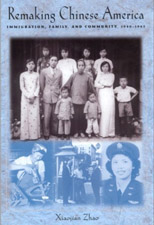Book Review
Remaking Chinese America: Immigration, Family, and Community, 1940-1965
By Xiaojian Zhao. New Brunswick, NJ: Rutgers University Press, 2002; xvii + 265 pp., illustrations, tables, notes, glossary, bibliography, index; cloth $59.00; paper $22.00.
 |
The history of the Chinese in the United States is entwined in American concerns about race, class, and gender. Because most Chinese who entered the country before World War II were male, the study of Chinese-American women has been slower to develop than other areas of the field. This work, therefore, makes an important contribution to our understanding of the Chinese-American experience, especially in terms of women's history, and the time period it covers, perhaps the most under-studied period in Chinese-American history.
American anxieties over Chinese immigration centered on labor competition and racial animosities. These anxieties manifested themselves in gendered concerns over the presence of Chinese immigrant women whom many Americans believed were innately disposed to prostitution. In 1875, Congress passed the Page Law that prohibited the immigration of Chinese contract laborers and prostitutes. However, since American officials often believed that most, if not all, Chinese women were or were going to become prostitutes, this law had the effect of barring most Chinese women from entering the country. Seven years later, the Chinese Exclusion Act barred the immigration of Chinese laborers for 10 years, and forbade those already in the country from bringing their wives and denied them naturalization. These two laws shaped the class and gender composition of Chinese immigrants into a predominantly male, small merchant and labor community. This gender imbalance and the passage of anti-miscegenation laws barring Chinese and white marriages stunted the growth and development of Chinese-American families.
Despite these restrictions, Zhao demonstrates that Chinese immigrants devoted considerable effort to gain entry for Chinese women into the United States. Appreciating the American legal system, Chinese immigrants and their allies petitioned the courts on behalf of those denied landing because they were accused of prostitution. Unable to prove that the women were ever involved in prostitution, the state had to allow many to land. However, the process of proving one's innocence was often so humiliating and onerous that many Chinese women chose not to go through the ordeal. Realizing how difficult it was for women to enter, Chinese immigrants tended to facilitate the immigration of males, presuming that they would have an easier time gaining entry, and once here, would have a better chance of finding employment.
America's entry into the World War II was a turning point for Chinese Americans. As Zhao documents, many women from Chinese immigrant communities contributed to the war effort by working in the defense industries or by joining the military. In both cases, it was often the first time that they were employed outside of Chinatown. They proved to a broader American society that Chinese Americans could perform with distinction, contributing to the improved image of Chinese Americans that developed during the war.
In 1943, the Chinese Exclusion Act was repealed allowing more Chinese to enter the country and naturalization of Chinese immigrants. As the war ended, the War Brides Act and subsequent amendments allowed Chinese Americans who had served in the military to bring their wives to the United States. This influx of women had a profound impact on the Chinese-American community as new families were formed and the American-born generation increased. But, as Zhao points out, most of the so-called "war brides" were not new wives but women who had been separated from their husbands in the United States due to exclusion restrictions.
Zhao extends her study beyond the close of the war to document the difficulties these women faced as they adjusted to new lives in the United States. Many had not seen their husbands for years and had to adjust not only to married life but to an alien society as well. Moving through the Cold War era, Zhao demonstrates how the Chinese-American community once again came under scrutiny because of suspected Communist sympathies. But in the long run, Chinese Americans were able to prove that they did not pose a threat and wanted to contribute to American society as Americans. Skillfully blending archival materials, oral histories, and secondary sources, Zhao offers us an insightful glimpse into a community in transition. This book is recommended to everyone interested in documenting and interpreting the Chinese-American experience.
K. Scott Wong
Williams College
